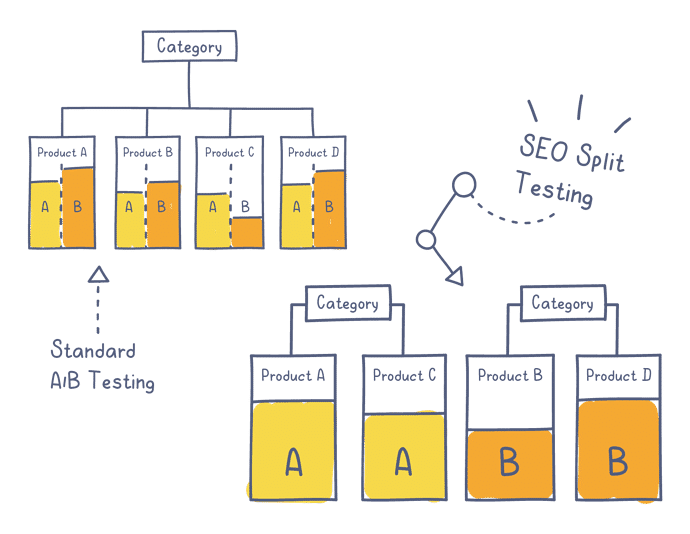SEO Conversion Optimization – Why You Should Test Your SEO Ideas Before You Ship Them?
Your conversion rate optimization (CRO) strategy fundamentally runs on two wheels—Search engine optimization (SEO) and A/B testing.
When you optimize your landing pages consistently to improve user experience by engaging visitors on your website, it signals to Google that your website fulfills the user intent. As a result, Google incentivizes you with a high ranking in the search.
SEO has evolved from being a traditional keyword-oriented model to a full-blown strategy as Google keeps changing its algorithm. User intent has become one of the top factors for ranking, but at the same time, it has become challenging for marketers to predict visitor behavior while making any changes in their SEO strategy.
Download Free: A/B Testing Guide
The logical resolution to the problem of figuring out what Google and visitors want from your website is rigorous testing of your SEO efforts.
This is good news because a) it is possible to run A/B tests without impacting SEO negatively and b) Google encourages A/B testing as long as it is done bearing in mind recommended best practices.
SEO conversion optimization is another key factor here that not only improves your website’s visibility on search engines but also ensures that the visitors coming to the website are offered an optimized experience that encourages them to take the desired actions.
In this blog post, we have covered the basics of SEO testing and how A/B testing can help you optimize your SEO efforts.

What is SEO testing?
SEO testing enables businesses to optimize their website performance on search engine result pages (SERPs). If you have ideas to optimize SEO for your website, you can do so by testing your ideas before you execute them at scale, which otherwise might pose a negative impact on your business if you ship the changes untested.
Testing is an important CRO practice that aims at optimizing critical elements to improve conversion rates. Moreover, SEO testing also allows you to make well-informed decisions that facilitate the planning of a smooth CRO roadmap in terms of both — strategy and budget.
The big advantage here is that Google encourages you to A/B test your SEO changes. You may test pages such as product pages, category pages, and elements like meta tags, copy format and relevancy, headlines, call-to-action buttons, and other SERP features.
These modifications are crawled by Googlebot and help Google learn new information and assess the implications of changes on your website for ranking.
Another key benefit of conversion rate optimization and SEO testing is that it allows you to optimize and choose the best version of elements that heavily impact user behavior such as page load speed, headlines, CTA copies, page layouts, and so on.
However, unlike A/B testing in conversion rate optimization, SEO testing is influenced by a couple of unique factors which are explained in the following sections.
SEO testing is different from A/B testing, as explained in the following sections.
What is Googlebot?
Google defines Googlebot as the crawler that visits web pages to include them within the Google Search index. In simple words, it is computer software or a bot that keeps learning new information on your web page and indexes the changes in Google’s database. It supports the latest JavaScript features that help them render the web pages to make ranking decisions.
Google declared the bot as the new evergreen Googlebot. And yes, there is just one Googlebot and it doesn’t like crawling duplicate pages as duplication confuses it. Let’s understand its function in bot-based testing.
Bot-based testing
With SEO bot-based testing, you run the split URL test and assess the control and variation response in a given period. It is done either to accept and deploy the changes to similar pages on your website or to reject the changes before moving on with your next experiment.
For example, let’s consider that you want to test your call-to-action (CTA) buttons as part of your SEO conversion optimization strategy. The goal is to rope your visitors in organically, which is why you want to compare the copy and positioning of the CTA on your website by running a split test.
The bot in such a test will be presented with unique web pages with unique CTAs that you want to test. It will crawl down the web pages to index the new information that you have presented through the test, thereby mitigating the chances of confusion for the bot. You will get the winner once the test signals a significant influx of visitors into the sales funnel, which eventually will be reflected in SERPs.
On the contrary, if you want to run an A/B test for CTA copy and positioning, you present a control version to a set of visitors and a variation to another set of visitors. Here, the bot may not be able to distinguish between the two pages (until you use link attributes to your original page, as discussed in best practices below), and it may confuse your testing situation with cloaking—a practice lethal for your SEO.

How do A/B testing and split URL testing impact SEO?
Simply put, they don’t. Your SEO and conversion rate optimization activities are not negatively impacted by testing activities as long as you’re not deliberately trying to confuse Googlebot.
Also, A/B testing and split URL testing are not the same. Your visitor will land on a variation or control purely by chance in an A/B test, whereas in split URL testing, they will land on statistically similar groups of pages as tests are hosted on different URLs. So, in A/B testing, you split users to test experiences, and in the latter, you split pages with distinct experiences.
For example, if you want to test your title tags which are key to SERPs, you can compare your title tags with SEO split testing, which will allow you to create groups of pages, say product pages, where you want to ship your changes to.
These pages are categorized into unique testing groups and hence appear alike to visitors and Googlebot. This type of testing is straightforward and effective for SEO conversion optimization. Whereas, it gets a bit tricky in A/B testing if you don’t follow the best practices.
Split URL testing is preferred for SEO conversion optimization when you need to test major changes like content format, navigation, design, etc. However, you can A/B test your SEO efforts as well keeping in mind a few factors that we will discuss in the following sections.

Best practices for A/B testing SEO activities
When it comes to A/B testing in SEO conversion optimization, Google has created stringent guidelines that must be followed to avoid any kind of negative impact on page visibility, user experience, or other key SEO factors.
Avoid cloaking
According to Google Webmaster guidelines, cloaking is showing one version to humans and others to bots. It’s deceptive to the search engines, bringing more harm to your website. Try always to serve the original content, otherwise, Google can demote your website.
Use 302 redirects
Always use a temporary 302 URL rather than 301. You may need to redirect some of your URLs to consolidate similar content pages into one or move your site to a new address.
Use rel=“canonical” to avoid duplication
While running an A/B test for minor changes on your web page, always add a link attribute to your alternative URLs for your testing pages. This linking enables Google to distinguish between the original and the variation. This is a key factor that can have a positive impact on your SEO conversion optimization efforts. For example, Google can index your homepage as a test variation if you want them to understand that you are running a test on your homepage. You can do so by identifying the page by using rel=”canonical”. It also signals to Google that other variations are close copies and should not be confused with the original URL.
Experiment runtime
Figure out what you want from the changes on the website. Since Google changes its algorithm all the time, be mindful of your test’s duration as your SEO might get affected if Google updates its algorithm while your test is running. This may, in turn, impact the metric you are testing. Such situations certainly get you skewed test results. A common advice that applies to both conversion rate optimization and SEO is not to run tests for long periods, unmonitored. If you want to see the positive impact of the variation, then you may want to conclude the test and make the changes live. However, if you want to gauge the scale of impact, then wait until your test reaches statistical significance.

Download Free: A/B Testing Guide
How does VWO help in running A/B tests and split URL tests without impacting SEO?
According to Google webmaster, website speed is one of the key factors impacting website ranking. Your SEO conversion optimization strategy must ensure that changes to the website have minimal impact on the loading speed.
This is where the VWO Asynchronous SmartCode comes into the picture.
It loads in parallel with your website, thereby having zero impact on your website load time. You can customize time-out parameters for the VWO SmartCode to execute and make sure that your visitors do not experience any inconsistent behavior while using the website. If the VWO SmartCode fails to execute within a specified time, it stops and then loads the original content of the page.
Watch the video to learn more about VWO sync and async SmartCode:
VWO Testing ensures that there is no negative impact on your website ranking while A/B testing your SEO elements. For example, if you want to A/B test some minor changes in the website, such as the copy, image, or color of a button, it usually has no impact on the page’s search result snippet or ranking. However, if you want to make changes like copy length and redesign your website, it is recommended that you follow best practices such as using query parameter rel= “canonical”.
For instance, if you have two different URLs ending with A.php and B.php, you can use the below code on B.php to avoid content duplication:
<head>
<link rel=”canonical” href=”http://vwo.com/A.php” />
</head>
Although Google will index both pages, you are enhancing Google’s knowledge to consider the original A.php for SEO by adding the above code.
Conclusion
SEO is a black box. Nobody knows the future of Google’s algorithms and how the search engine perceives your unique web pages.
The closest you could get to understanding it is by acknowledging that Google is getting smarter every minute as you read this blog piece. The only way to boost your SEO conversion optimization activities is through consistent research and experimentation.
Just like the COVID vaccines. There are so many other factors at play you can only say with some reasonable amount of confidence that you can expect the results to come out a certain way.
Kevin Indig, Head of SEO, Shopify
The only solution to crack SEO conversion optimization for revenue generation is to keep testing, and keep optimizing your website experience!












